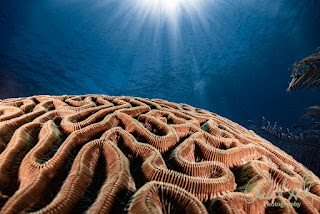20 Common Mistakes in Underwater Photography and How to Avoid Them
 |
| AI-generated image. |
Underwater photography can be extremely rewarding, but it also presents unique challenges. Whether you're a beginner or looking to improve your skills, avoiding common mistakes can greatly impact your results. Here are the top 20 mistakes that underwater photographers often make and how to avoid them.
1. Not Getting Close Enough
Mistake: Staying too far from your subject results in unclear and colorless images due to water absorption.
Solution: Get as close as possible to your subject, ideally within a few feet, to capture vivid colors and details.
Detailed Tip: Use a wide-angle lens to get closer while fitting more of the scene into your frame. This minimizes the amount of water between the camera and the subject, reducing color loss and haze.
2. Ignoring Buoyancy Control
Mistake: Poor buoyancy control can result in shaky shots and harm to the environment.
Solution: Regularly practice buoyancy skills. Having perfect buoyancy allows you to maintain stability and avoid disturbing marine life.
Detailed Tip: Consider enrolling in a buoyancy control course and practicing in a pool before your dive trips. Proper weighting is crucial; carrying too much weight can cause you to sink and struggle, while too little can make you float uncontrollably.
3. Using the Wrong Lens
Mistake: Using inappropriate lenses, such as telephoto lenses, underwater.
Solution: Use wide-angle lenses for larger subjects and macro lenses for close-ups to capture the best details.
Detailed Tip: Wide-angle lenses are ideal for capturing large scenes like wrecks or schools of fish, while macro lenses are perfect for small creatures like nudibranchs. Experiment with both to understand their strengths and limitations.
4. Poor Lighting Management
Mistake: Relying solely on natural light results in dull photos with poor color representation.
Solution: Use strobes or external lights to enhance colors and reduce shadows. Learn to position your lights correctly.
Detailed Tip: Position your strobes at a 45-degree angle from your subject to minimize backscatter and illuminate your subject evenly. Experiment with different lighting angles to see how shadows and colors change.
5. Overexposing or Underexposing Photos
Mistake: Incorrect exposure settings can ruin your photos.
Solution: Use the histogram on your camera to check exposure levels and adjust settings accordingly.
Detailed Tip: Bracketing your shots by taking multiple photos at different exposures can ensure you get a properly exposed image. Adjust ISO, aperture, and shutter speed to find the right balance.
6. Neglecting Camera Maintenance
Mistake: Skipping regular maintenance can lead to equipment failure.
Solution: Rinse your gear with fresh water after every dive and check for leaks or damages.
Detailed Tip: Regularly inspect O-rings and seals for wear and tear. Lubricate them with appropriate grease to ensure they remain flexible and effective. Check your housing for cracks or scratches that could compromise its waterproof integrity.
7. Ignoring the Background
Mistake: Focusing only on the subject and ignoring the background, leading to cluttered or distracting photos.
Solution: Pay attention to the background and try to position your subject against a clean, contrasting backdrop.
Detailed Tip: Move around your subject to find an angle where the background is less busy. Use a shallow depth of field to blur out distracting elements behind your subject.
8. Shooting at the Wrong Time of Day
Mistake: Shooting in low-light conditions without proper lighting equipment.
Solution: Dive during times with optimal light conditions or bring adequate artificial lighting.
Detailed Tip: Early morning and late afternoon often provide the best natural light. However, mid-day dives might be better for deeper dives due to more available light. Always bring sufficient lighting gear to compensate for low light at depth.
9. Not Understanding Marine Life Behavior
Mistake: Scaring away subjects or failing to capture their natural behavior.
Solution: Learn about the behavior of marine life to approach them calmly and predict their actions.
Detailed Tip: Study the habits and habitats of marine species you wish to photograph. Patience is key - move slowly and avoid sudden movements to gain the trust of your subjects.
10. Incorrect White Balance
Mistake: Using auto-white balance can result in unnatural colors.
Solution: Manually set the white balance based on the depth and lighting conditions, or correct it in post-processing.
Detailed Tip: Use a white slate or your hand as a reference for setting white balance manually underwater. Alternatively, shoot in RAW format to easily adjust the white balance during post-processing.
11. Ignoring Composition Rules
Mistake: Poor composition can make even technically perfect photos uninteresting.
Solution: Follow basic composition rules like the rule of thirds, leading lines, and framing to create visually appealing images.
Detailed Tip: Apply the rule of thirds by placing your subject off-center, creating a more dynamic and balanced composition. Use natural lines like coral formations or sun rays to lead the viewer's eye to the main subject.
12. Forgetting to Check Camera Settings
Mistake: Using incorrect settings from previous dives.
Solution: Always check and reset your camera settings before starting a dive to ensure they're optimized for current conditions.
Detailed Tip: Create a pre-dive checklist that includes checking ISO, aperture, shutter speed, white balance, and focus settings. Reset your settings to default after each dive to avoid starting the next dive with incorrect settings.
13. Not Being Patient
Mistake: Rushing to capture shots can result in missed opportunities.
Solution: Be patient and wait for the right moment to capture the perfect shot.
Detailed Tip: Observe your subject and wait for interesting behaviors or actions. Patience often leads to more natural and compelling images.
14. Failing to Secure Equipment
Mistake: Losing or damaging equipment due to improper handling.
Solution: Use lanyards and clips to secure your gear and regularly check attachments.
Detailed Tip: Attach floatation devices to smaller items like lights or cameras to prevent them from sinking if dropped. Regularly check that all attachments and clips are secure before and during your dive.
15. Underestimating Post-Processing
Mistake: Ignoring the importance of editing.
Solution: Learn basic post-processing techniques to enhance your photos, such as adjusting exposure, color correction, and cropping.
Detailed Tip: Invest time in learning software like Adobe Lightroom or Photoshop. Use these tools to adjust white balance, enhance colors, and remove backscatter to improve the overall quality of your images.
16. Not Practicing Enough
Mistake: Expecting perfect results without sufficient practice.
Solution: Practice regularly to improve your skills and understand your equipment better.
Detailed Tip: Practice in controlled environments like pools or shallow waters before venturing into more challenging conditions. Regular practice helps you become more familiar with your gear and improves your ability to adapt to different underwater scenarios.
17. Using High ISO
Mistake: Setting ISO too high can introduce noise into your images.
Solution: Use the lowest ISO possible to maintain image quality, relying on external lighting to compensate for low light.
Detailed Tip: Test your camera's ISO performance in various conditions to find the highest usable ISO setting before noise becomes unacceptable. Use external lights or strobes to avoid increasing ISO unnecessarily.
18. Not Customizing Gear for Comfort
Mistake: Using standard gear that may not fit well or be comfortable.
Solution: Customize your gear for comfort and efficiency, ensuring it fits well and is easy to manage underwater.
Detailed Tip: Test different configurations and adjustments to find what works best for you. Consider investing in ergonomic grips, harnesses, or custom-molded components to enhance comfort and functionality.
19. Ignoring Safety Precautions
Mistake: Focusing too much on photography and neglecting dive safety.
Solution: Always prioritize safety over photography. Be aware of your surroundings, dive limits, and buddy.
Detailed Tip: Establish clear communication with your dive buddy and agree on hand signals for specific scenarios. Regularly monitor your air supply and depth, and never compromise safety for a photo opportunity.
20. Test Your Equipment Before You Dive
Mistake: Failing to check that all equipment is functioning properly.
Solution: Test your camera, housing, and strobes or lights before diving to ensure they are working correctly.
Detailed Tip: Charge all batteries fully and bring spares. Check seals for integrity and apply silicone grease to O-rings. Perform a dunk test with your housing before each dive to ensure there are no leaks. Make sure all buttons and controls function smoothly.
Conclusion
To significantly enhance your underwater photography, be mindful of these common mistakes. As you perfect your skills, you'll be able to capture more breathtaking, professional-grade images. Remember, practice and patience are vital. Keep an eye out for the continual improvement and evolution of Lightroom's AI functions and tools, as it introduces new features to further elevate your editing capabilities.
By avoiding these common mistakes, you will improve your underwater photography skills and capture the beauty of the underwater world more effectively.
Stay Connected
Follow my blog for more tips and tutorials on underwater photography. Let's dive deeper into the art and craft of capturing the marine world!
Subscribe to my blog for more tips and tutorials on underwater photography. Don’t forget to share your processed photos on social media using the hashtag #RobertHerbPhotography. I look forward to reviewing your results.
New Online Training Program
I am excited to announce that I am creating an online training program to teach underwater hobbyists and enthusiasts how to enhance their photos using Adobe Lightroom. If you are interested in this training, please contact me at bob@robertherb.com to express your interest and to be notified about the details and start date of the classes.
Stay tuned and "Follow" for upcoming blogs on underwater photography tips and tricks for more in-depth insights. Please leave your comments and suggestions. Enjoy your diving and shooting experience!
I am eagerly anticipating your valuable feedback and suggestions.
Sincerely,
Bob Herb
|
|




Comments
Post a Comment
Please let me know your comments.